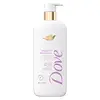What's inside
What's inside
 Key Ingredients
Key Ingredients

 Benefits
Benefits

 Concerns
Concerns

 Ingredients Side-by-side
Ingredients Side-by-side

Water
Skin ConditioningCocamidopropyl Betaine
CleansingSodium Lauroyl Isethionate
CleansingSodium Methyl Lauroyl Taurate
CleansingLauric Acid
CleansingSodium Hydroxypropyl Starch Phosphate
AbrasiveHydrogenated Soybean Oil
EmollientHydrogenated Vegetable Glycerides
EmollientGlycine Soja Oil
EmollientGlycerin
HumectantParfum
MaskingSodium Chloride
MaskingStearic Acid
CleansingPalmitic Acid
EmollientHydroxystearic Acid
CleansingGlyceryl Stearate
EmollientCollagen
MoisturisingGuar Hydroxypropyltrimonium Chloride
Skin ConditioningSodium Benzoate
MaskingCapryloyl Glycine
CleansingUndecylenoyl Glycine
CleansingSodium Gluconate
Skin ConditioningCitric Acid
BufferingBenzyl Alcohol
PerfumingBenzyl Salicylate
PerfumingCoumarin
PerfumingHydroxycitronellal
PerfumingLimonene
PerfumingWater, Cocamidopropyl Betaine, Sodium Lauroyl Isethionate, Sodium Methyl Lauroyl Taurate, Lauric Acid, Sodium Hydroxypropyl Starch Phosphate, Hydrogenated Soybean Oil, Hydrogenated Vegetable Glycerides, Glycine Soja Oil, Glycerin, Parfum, Sodium Chloride, Stearic Acid, Palmitic Acid, Hydroxystearic Acid, Glyceryl Stearate, Collagen, Guar Hydroxypropyltrimonium Chloride, Sodium Benzoate, Capryloyl Glycine, Undecylenoyl Glycine, Sodium Gluconate, Citric Acid, Benzyl Alcohol, Benzyl Salicylate, Coumarin, Hydroxycitronellal, Limonene
Water
Skin ConditioningCocamidopropyl Hydroxysultaine
CleansingSodium Cocoyl Isethionate
CleansingSodium Cocoyl Taurate
CleansingNiacinamide
SmoothingGlycerin
HumectantSodium Chloride
MaskingGlycol Distearate
EmollientCoconut Acid
CleansingSodium Isethionate
CleansingPCA Glyceryl Oleate
EmollientTetrasodium Glutamate Diacetate
Xylitol
HumectantEthylhexylglycerin
Skin ConditioningSodium Phosphate
BufferingSodium Hydroxide
BufferingPhenoxyethanol
PreservativeWater, Cocamidopropyl Hydroxysultaine, Sodium Cocoyl Isethionate, Sodium Cocoyl Taurate, Niacinamide, Glycerin, Sodium Chloride, Glycol Distearate, Coconut Acid, Sodium Isethionate, PCA Glyceryl Oleate, Tetrasodium Glutamate Diacetate, Xylitol, Ethylhexylglycerin, Sodium Phosphate, Sodium Hydroxide, Phenoxyethanol
 Reviews
Reviews

Ingredients Explained
These ingredients are found in both products.
Ingredients higher up in an ingredient list are typically present in a larger amount.
Glycerin is already naturally found in your skin. It helps moisturize and protect your skin.
A study from 2016 found glycerin to be more effective as a humectant than AHAs and hyaluronic acid.
As a humectant, it helps the skin stay hydrated by pulling moisture to your skin. The low molecular weight of glycerin allows it to pull moisture into the deeper layers of your skin.
Hydrated skin improves your skin barrier; Your skin barrier helps protect against irritants and bacteria.
Glycerin has also been found to have antimicrobial and antiviral properties. Due to these properties, glycerin is often used in wound and burn treatments.
In cosmetics, glycerin is usually derived from plants such as soybean or palm. However, it can also be sourced from animals, such as tallow or animal fat.
This ingredient is organic, colorless, odorless, and non-toxic.
Glycerin is the name for this ingredient in American English. British English uses Glycerol/Glycerine.
Learn more about GlycerinChances are, you eat sodium chloride every day. Sodium Chloride is also known as table salt.
This ingredient has many purposes in skincare: thickener, emulsifier, and exfoliator.
You'll most likely find this ingredient in cleansers where it is used to create a gel-like texture. As an emulsifier, it also prevents ingredients from separating.
There is much debate on whether this ingredient is comedogenic. The short answer - comedogenic ratings don't tell the whole story. Learn more about comegodenic ratings here.
The concensus about this ingredient causing acne seems to be divided. Research is needed to understand if this ingredient does cause acne.
Scrubs may use salt as the primary exfoliating ingredient.
Learn more about Sodium ChlorideWater. It's the most common cosmetic ingredient of all. You'll usually see it at the top of ingredient lists, meaning that it makes up the largest part of the product.
So why is it so popular? Water most often acts as a solvent - this means that it helps dissolve other ingredients into the formulation.
You'll also recognize water as that liquid we all need to stay alive. If you see this, drink a glass of water. Stay hydrated!
Learn more about Water